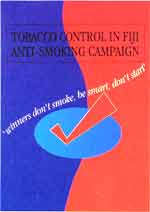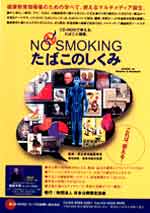NOTE: Suggested
activities for the Regional and National Plans of Action are given in
the Annex.
PRODUCTS:
| 1.0 |
WHO collaboration
with Member States in support of the development of National Plans
of Action on Tobacco or Health
|
| 1.1 |
WHO collaboration with Member States
in support of the development of National Plans of Action on Tobacco
or Health
Types of support:
- technical advisory services [consultants]
- local costs to support workshops and training
- Agreements for the Performance of Work [these require tangible
outputs with inter-country significance]
- fellowships and study tours
- supplies and equipment
|
| 1.2 |
Guidance for the development of
National Plans of Action
|
| The World Health Organization has taken many significant
actions at meetings of the World Health Assembly and Western Pacific
Regional Committee to encourage tobacco control. Many countries
are developing national plans with different levels of comprehensive
action. Because of the time lag between the uptake of smoking
and disease manifestation, which is sometimes from 20 to 30 years,
many countries in the Region are now most vulnerable to the impact
of tobacco and are seeing significant increases in diseases caused
by tobacco. |
 |
| 2.0 |
Policies, legislation and regulations that
deter tobacco use
|
| 2.1 |
WHO collaboration with Member States in support
of the development of policies, legislation and regulations
Types of support: (as indicated in Section 1.1 above)
|
| 2.2 |
Guidance for the development of national policies,
legislation and regulations that deter tobacco use
Comprehensive policy:It is recommended that each country
should develop a substantial plan, with a focus on comprehensive
tobacco control measures. These measures should involve legislation,
regulation and education and should be based on strategies that
have proven effective.
Policies to prevent the uptake of smoking and deter tobacco use
have been researched for the past 40 years. Several recent WHO
publications and other reviews have outlined the most effective
strategies in developed countries. Using the best current knowledge
and recognizing that each country is at a different stage in terms
of taking action on tobacco or health, it is suggested that national
policies, legislation and regulations should reflect the strategies
outlined on page 10. |
Range of Effective strategies1,2,3,4
- Excise tax policy based on raising the real price of tobacco;
- A total ban on all forms of advertising, sponsorship and
promotion;
- A comprehensive and enforced approach to banning smoking
in all enclosed public places, and the application of measures
to minimize exposure to children and non-smokers;
- Dedicated ongoing funding for mass information campaigns,
especially well-researched counter-advertising strategies;
- Comprehensive efforts to eliminate access of the young to
tobacco products;
- The incorporation of advice on cessation and minimal intervention
programmes into routine health care services and in community
settings;
- Strong, prominent pack warnings, including generic packaging
and full product disclosure and testing at manufacturer's
expense;
- The ending of financial assistance to the tobacco industry,
for production, sales or marketing.
- "Curbing the Epidemic: Governments and the Economics of
Tobacco control", the World Bank, Washington, D.C., 1999.
- "The Economics of Tobacco control", I.Abadian, R.van der
Merwe, N.Wilkins, and P.Jha (eds.), Applied Fiscal Research
Centre, University of Cape Town, South Africa, 1998.
- "Guidelines for controlling and Monitoring the Tobacco
Epidemic", the World Health Organization, Geneva, 1998.
- "Tobacco or Health: A Global Status Report", the World
Health Organization, Geneva, 1997.
|
| 3.0 |
Advocacy, educational
and promotional campaigns and materials that encourage people
not to start and to quit smoking
If educational strategies are employed on their own, it has been
demonstrated that they have minimal impact. The most effective
educational and promotional strategies appear to be those with
highly focused, direct media impact. It is evident that countries
that focus exclusively on traditional school or adult education,
with no accompanying comprehensive strategies, will have little
impact on reducing tobacco use prevalence rates. Therefore maximizing
media exposure must accompany educational campaigns.
|
| 3.1 |
WHO collaboration with Member States
in support of the development of advocacy, educational and promotional
campaigns and materials that encourage people not to start and
to quit smoking
Types of support: (as indicated in Section 1.1. above)
|

World No-Tobacco Day 1999
- Manila, Philippines
|
| 3.2 |
Questions to be addressed
in developing national advocacy, educational and promotional campaigns
and materials that encourage people not to start or to quit smoking
|
- How can social marketing play a role in helping countries
achieve their own or WHO Regional Tobacco or Health objectives?
- To what extent will these strategies contribute to the strengthening
of positive attitudes and the decreasing of negative attitudes
towards controlling tobacco use and promotion?
- What recommendations can be prepared for countries with
minimal resources for social marketing?
- Who should be the target audiences for such campaigns? Consider:
the general public, professionals, politicians, and policy
makers.
- How should the WHO initiative for a "Tobacco Advertising-Free
Region by the year 2000" be handled in the new millennium
or integrated with the Framework Convention on Tobacco Control?
- Is the integration of curriculum materials on smoking important
for schools, colleges or universities?
|
 |
| 4.0 |
Research, monitoring and evaluation
Over the last five years, monitoring of the tobacco epidemic has
been coordinated through the WHO Western Pacific Regional Office.
Prior to the 1996 Beijing World Conference, a meeting of WHO staff
and other key personnel focused on database development and coordination
issues. This resulted in the development of the regional tobacco
or health (TOH) questionnaire. In relation to monitoring, it is
suggested that the existing TOH questionnaire can serve as the
basis for monitoring and evaluation activities at both the Regional
and national levels through the countries' focal persons on tobacco
or health. It is recognized that the availability of complete
survey information varies from country to country at present.
The long-term goal is for each country to be able to compile reliable
information and share it with other countries throughout the world.
|
| 4.1 |
WHO collaboration with Member States in support
of research, monitoring and evaluation
Types of support: (as indicated in Section 1.1 above)
|
| 4.2 |
Guidance for the development of national activities
in relation to research, monitoring and evaluation
- To what extent can research on prevalence of smoking be
incorporated into other surveys or national census data?
- What are the most useful questions, or sets of questions,
so that surveys do not become unwieldy?
- How can low budget programmes on TOH be effectively evaluated?
- How should countries respond to the current research showing
that educational programmes on tobacco are relatively ineffective?
|
|

